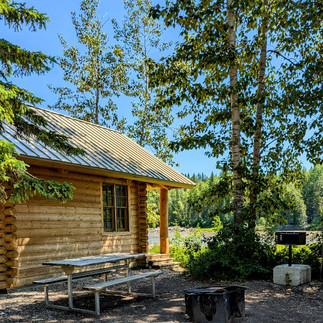Rocky Mountain House National Historic Site
- Lyn (aka Jazz)

- Aug 5, 2024
- 5 min read
Updated: Aug 18, 2024
Have you ever craved a dip into history, surrounded by breathtaking natural beauty? If so, a visit to Rocky Mountain House National Historic Site is an experience for you.
Located in the heart of the Canadian Rockies, the Rocky Mountain House National Historic Site offers a retreat that is 213 km from Calgary, 238 km from Edmonton, and 600 km from Vancouver. For those travelling along the Icefields Parkway between Banff and Jasper, head east 178 km along Hwy 11 at Saskatchewan Crossing (178 km) for a glorious drive past stunning Abraham Lake, which demands a stop for a swim and a picnic or a night or two of camping at one of the numerous campgrounds and recreational sites.

As an experienced road tripper, my road trip had started in Vancouver, and I had already explored the Rocky Mountain National Parks of Kootenay (click here), Mount Revelstoke (click here), Mount Robson (click here), Banff (click here), and the first half of the Icefields Parkway in Jasper when I spontaneously decided to take a detour to visit Rocky Mountain House, an important fur fort in Canada's history.

I'm a retired teacher and have been spending my summer road trips visiting as many of the historical sites featured in the lessons I taught in Canadian history classes. With the whole summer ahead and a flexible schedule, I welcomed the opportunity to spend a few days in David Thompson Country.
David Thompson Country
David Thompson Country is an area in West Central Alberta known for its incredible landscapes of mountains and lakes. It is ideal for camping, hiking, and canoeing/kayaking, and its history is older than that of Canada. Stunning Abraham Lake is a can't-miss turquoise lake that dominates the area. Keep an eye out for wildlife. I was thrilled to spot this grizzly along the Highway.

David Thompson was a British explorer who walked and paddled over 80,000 km of Canada and was responsible for mapping most of Western Canada during the late 1700s and early 1800s. He was recruited by the Hudson Bay Company at the tender age of 14 as a clerk and travelled to Churchill, Manitoba, to begin his career. He was taught accounting, navigation and surveying by the Royal Navy. He later went to work for HBC's competitor, the North West Company, after the company's priority changed from surveying to focusing on the profitable fur trade.

At 17 years old, Thompson left Churchill to walk and paddle to Rocky Mountain foothills, home to the Blackfoot people. He was welcomed by the Indigenous people and lived with them for a winter. At age 29, he married a Métis girl, Charlotte Small (she was 13!). Their marriage lasted 58 years and produced 13 children. Charlotte and the children often accompanied David on his journeys.
Over his lifetime, Thompson learned to speak several Indigenous languages and was known as a sympathetic supporter of the Indigenous people -- a very rare attitude for the times.
Rocky Mountain House National Historic Site
The story of Rocky Mountain House dates back to the early 19th century, when it served as a pivotal trading post. Both the Hudson Bay Company (HBC) and the North West Company (NWC) established fur-trading forts in Rocky Mountain House along the edge of the North Saskatchewan River. These remote posts traded international goods such as tea, guns, beads, and metal pots in exchange for the furs and food supplied by the native people.

Four different forts were built in the area, one by the NWC and three by the HBC, known as Acton House. The companies were fierce rivals, often resulting in skirmishes. By 1821, the two companies merged, keeping the NWC name of Rocky Mountain House.

Today, little remains of the original forts. Parks Canada has created a site where the original forts were located. The site includes a visitor's centre, gift shop, bison paddock, Métis camp, blacksmith shop, and play fort. Three walking/biking trails wind around the site.

The Chimney Trail
The Chimney Trail (0.8 km loop) circles around the remains of two of the HBC fort sites. Interpretive signs highlight the stories and landscape. The trail goes through the former residential area where two of the original fort chimneys still stand. It also passes the blacksmith shop and a cemetery where the human remains discovered during excavation have been re-interred.

The David Thompson Trail
The David Thompson Trail (3.2 km) loop follows the banks of the North Saskatchewan River through the woods to the oldest fort sites. Here visitors will see a replica Yorkboat, a memorial to Charlotte Small, and the iconic Parks Canada Red Chairs viewpoint.

An interesting exhibit on this trail is the Centennial Canoe which was part of Canada's Centennial celebrations in 1967. Ten teams representing 8 provinces and two territories paddled and portaged from the Rocky Mountains to Montreal in just over 100 days.

The Bicentennial Trail
The Petro Canada Bicentennial Trail is a 5km loop linking the National Historic Site to the town of Rocky Mountain House. It goes through aspen woods and old-growth forests and includes a spectacular view of Clearwater County.

Costs and Admission
Get Your Park Pass
Be aware that you will need to purchase a Park Pass for all National Parks. A day pass will cost $11. If you plan on visiting other national parks in the area or are staying more than 6 days, consider purchasing a "Discovery Pass" good for a full year.
Discovery Pass
Adult (18+) $75.25
Senior (65+) 64.50
Family 151.25
Youth, New Canadian Citizens, Canadian Military, Disability Support people FREE
Buy online from Parks Canada or at any Park Entrance

Admission to Rocky Mountain National Historic Site
The cost for visiting the Historic Site is very reasonable and fits any traveller's budget.
Adult $9.00 (Seniors $7.50)
Youth Free

Accommodations at Rocky Mountain Historic Site
For a truly immersive experience, visitors can stay at the Park. Accommodations include camping sites (tent and RV sites), Métis Trapper Tents or Tipi, or choose to book one of the fully serviced Trapline cabins. The tents and Trapline Cabins are very popular and should be reserved in advance. I had no problem securing a campsite on the day I arrived without a reservation.
Front County Camping $28.50
Tipi & Métis Trapper Tents $78.00
Trapline Cabins $133.25
The Town of Rocky Mountain House
The town is small but has all the services that any traveller needs including bistros and artisan shops, restaurants, malls, and hotels for those preferring to stay in a more urban setting.

Shout out to Barbaric Auto Service, who made room for me in their busy schedule, realized that my regular mechanic had mistakenly installed a too-small brake pad, and made multiple attempts to get the correct part number and size. When it became clear that it couldn’t be done in my time frame, Barbaric MacGivered a solution which would work until I could return it to my mechanic. Efficient, creative, and fair.
Final Thoughts
To understand Canadian history, one must understand the fur trade. A visit to Rocky Mountain House gives a glimpse into the trade connections with the indigenous people, the intrepid explorers, and the challenges faced by trappers and traders. The site is well-designed and provides excellent interpretive signage and informative guided tours. I recommend a visit for history and nature fans.

If you are enjoying the content and would like to be kept up to date with new posts become a member/subscribe (it's free!) and follow along on the RamblynJazz Facebook page, Facebook Group, Twitter, and Instagram. You can help the blog to grow by sharing the link with a travelling friend or through social media. I truly appreciate your comments and encourage you to share your thoughts below.
























The landscapes you portray in your photos always leave me speechless, and these are no exception. What wonderful mountains you managed to photograph!
Rocky Mountain National Parks, the history of David Thompson and the place, make for an absolutely unmissable combo.
I really liked the accommodation option, it seems quite within the context of the surrounding environment. Angela | Blonde Around The World Travel -
After visiting other national historic sites I'd like to see Rocky Mountain House too. Especially given the wonderful scenery you can find all around and on the way there. I think I'd have to book one of those tents to stay in too. Great shot of the grizzly. I guess better that he is unaware of you vs too interested in you
Look at those mountains! They're absolutely stunning. You got some amazing weather and clear skies for your pictures! While I want to go for the beautiful nature, I think Rocky Mountain House would give a great look into the people who live here and the history of the area! great post!
Nice little personal fact in your intro, I didn't know you were a teacher and now seek out most of the places you have taught in school. From having followed your blog for a while now, I can always read a lot of enthusiasm and interest for Canada and its National Parks out of your writing. With your experience teaching, I am intrigued which part of the country has surprised you the most. The Rocky Mountains are just so well known and iconic all over the world and I enjoyed reading about the Canadian side of this mountain range. Once again, it strikes me as a region that is characterised by natural beauty, trade and a long indigenous history.
Carolin…
David Thompson - what a career he had and a legacy too aside from of course having 13 offspring. It's great finding out the fur trade and how it came about in this part of Canada. I have not tried sleeping in a tipi but very much look forward to at some point #flyingbaguette
Jan - https://flyingbaguette.com/